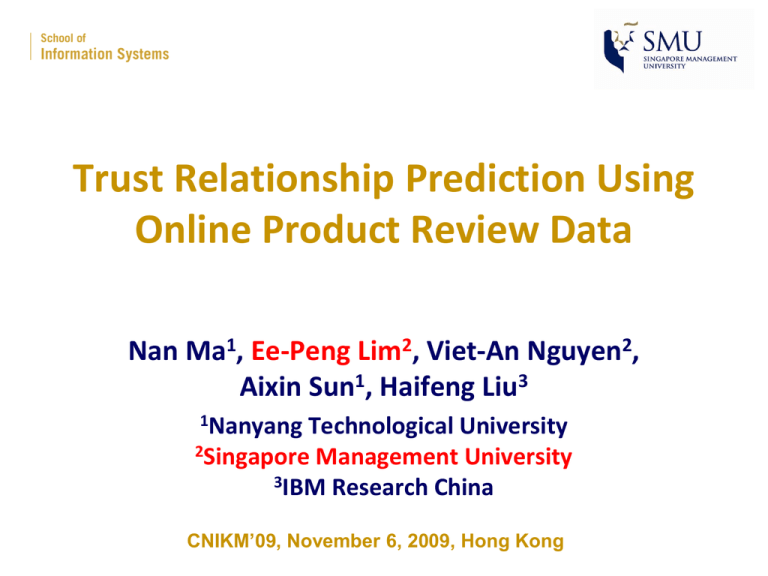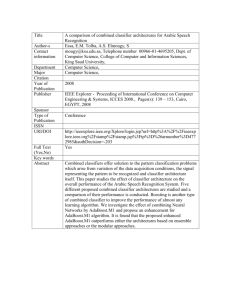Trust Relationship Prediction Using Online Product Review Data Nan Ma ,
advertisement

Trust Relationship Prediction Using
Online Product Review Data
Nan Ma1, Ee-Peng Lim2, Viet-An Nguyen2,
Aixin Sun1, Haifeng Liu3
1Nanyang
Technological University
2Singapore Management University
3IBM Research China
CNIKM’09, November 6, 2009, Hong Kong
Motivation
• Online links between users are getting
popular.
Facebook network
Epinion’s Web of Trust
trust
B
trust
A
trust
C
trust
D
distrust
trust
E
2
Trust relationships
• Trust is a user-user link.
• Web of Trust (WOT):
– A network of users and their trust + distrust links
– This paper focuses on trust links only
trustor
A
trust
B
trustee
• Trust can be used in various applications
– Personalized search
– Personalized recommendation
– P2P file sharing
3
Trust Data Sparseness
• A few users with many trust relationships.
• Majority users with few or no trust
relationships.
– Users may be lazy.
– Users just don’t have many trusted friends.
• A lack of trust relationships → difficulties in
building useful applications.
4
Research Goal
• To predict trust among users –
Trust Prediction
• Previous trust prediction work
– Trust propagation: [WWW2004, AAAI2005,
TOIT2006]
• A trusts B, B trusts C → A trusts C
– Trust classification: [EC2008,WWW2009]
• Represent a user pair (A,B) by a set of features.
• Train a classifier to label (A,B) as trusted pair or not.
• Apply the trained classifier on unseen user pairs.
5
Contribution
• We take the trust classification approach.
– Features from both user and user-user interaction
• We use two Epinions datasets.
– EpinionsVideo
– EpinionsTrustlet
• Previous trust classification approaches:
– Global classifier is used. Treat every user the same.
• Apply personalized and cluster-based classifiers to
trust prediction.
6
Epinions schema
Category
Product
1
Posting time
Text
has
Posting time
n
Score
1
Review
1
Text
has
n
Comment
n
n
writes
has
writes
n
Score
Time
Rating
1
1
User
n
rates
1
trusts
7
EpinionsVideo + EpinionsTrustlet
• EpinionsVideo
– We crawled product reviews and Web of Trust
of“Videos & DVDs”category on April 15, 2008.
• EpinionsTrustlet
– Made available by Massa for trust research
– Product reviews and ratings from all categories
before May 30, 2002, and both Web of trust and
distrust relationships before August 12 2003.
8
Statistics
9
WOT Statistics
EpinionsVideo
EpinionsTrustlet
10
Overview of General Classification (GC)
Approach
Labeled
Training
Pairs
Classifier
Training
Trained
Classifier
Apply
Classifier
Labeled
Training
Pairs
SVM
Labeled
Training
Pairs
11
User Interactions in Epinions
• Users can interact with one another in the
following forms:
(a) one reads the reviews written by another
(b) one rates the reviews written by another
(c) one comments on the reviews written by another
(d) one reads the ratings by another
(e) one reads the comments by another
12
User Interactions in Epinions
• Users can interact with one another in the
following forms:
(a) one reads the reviews written by another
(b) one rates the reviews written by another
(c) one comments on the reviews written by another
(d) one reads the ratings by another
(e) one reads the comments by another
• Only (b) and (c) are observable in our data.
• We use mainly (b) in this paper.
13
Review Rating Statistics
• Write-rate writer count of ui
= # of review writers rated by ui
14
User and Interaction Features for (u1,u2)
u
i
Known to be good features in our earlier work.
i
i
u
u
i
u
u
u
u
i
u
u
i
u
u
i
u
i
i
15
Cluster-Centric + Personalized Classification
• Earlier classification approach uses a global
classifier (GC)
• GC may not suit all users as each user may
have different criteria to trust
• Personalized classifier (PC):
– One classifier for each user (as trustor)
• Cluster-centric classifier (CC):
– One classifier for a cluster of users (as trustors)
16
CC Method – Clustering of Users
• Graph partitioning
• Divisive hierarchical clustering method using
normalized minimum cut [TPAMI2000]
– Directions of trust relationships are ignored
– Edge weight of (u1,u2) =
• 2 if u1 and u2 trust each other
• 1 if only u1 trusts u2
• 0 otherwise
– Normalized Cut of user sets UA and UB
17
Experiment Setup
• To evaluate GC, CC, and PC methods
• Enough training data?
– Users with write-rate writer count >= 50
– Users with # trustees among rated writers >= 25
• User activeness
– measured by write-rate writer count
– Highly active users (Ut): top 500 with highest counts
– Less active users (Ub): bottom 500 with lowest counts
18
User Activeness Statistics
19
Methods to be evaluated
• {GC,CC,PC} - {Active, LessAct} combinations
• CC with k= 2 to 10 clusters
• User pairs (ui,uj)’s for experiments
For each Active (or LessAct) user ui,
include all uj’s that ui rates and trusts; and
equal number of other users uj’s ui has no trust
relationships with.
• F1= 2 Precision x Recall / (Precision + Recall)
• Results obtained using 5-fold validation
20
F1 Results – EpinionsVideo
F1
0.9
0.85
GC-Active
0.8
PC-Active
CC-Active
0.75
GC-LessAct
PC-LessAct
0.7
CC-LessAct
0.65
K clusters
0.6
1
2
3
4
5
6
7
8
9
10
21
F1 Results - EpinionsTrustlet
F1
0.9
0.85
GC-Active
0.8
PC-Active
CC-Active
0.75
GC-LessAct
PC-LessAct
0.7
CC-LessAct
0.65
K clusters
0.6
1
2
3
4
5
6
7
8
9
10
22
F1 of PC classifiers - EpinionsVideo
23
F1 of PC classifiers - EpinionsTrustlet
24
Comparison of Propagation and
Classification Approaches
• Trust propagation method: Moletrust
• Limitation: can only predict if there is a path
from trustor to trustee.
• Leave out such user pairs from experiment.
25
Conclusions
• Trust prediction using classification methods using
both user and user interaction features.
• Personalized and Cluster centric classification.
– Training examples relevant to trustors are more useful.
• Active users enjoys better prediction accuracy
• Classification methods are better than propagation
methods
• Future works:
– Other interaction features
– User clustering
– Trust aware search and recommendation
26
Thank you
Ee-Peng Lim
eplim@smu.edu.sg





